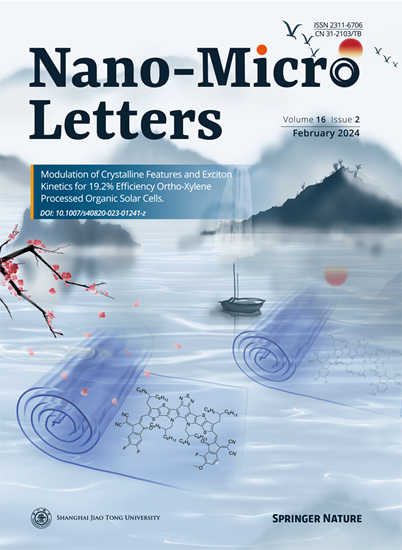Lattice Anchoring Stabilizes α-FAPbI3 Perovskite for High-Performance X-Ray Detectors.
IF 36.3
1区 材料科学
Q1 Engineering
引用次数: 0
Abstract
Formamidinium lead iodide (FAPbI3) perovskite exhibits an impressive X-ray absorption coefficient and a large carrier mobility-lifetime product (µτ), making it as a highly promising candidate for X-ray detection application. However, the presence of larger FA+ cation induces to an expansion of the Pb-I octahedral framework, which unfortunately affects both the stability and charge carrier mobility of the corresponding devices. To address this challenge, we develop a novel low-dimensional (HtrzT)PbI3 perovskite featuring a conjugated organic cation (1H-1,2,4-Triazole-3-thiol, HtrzT+) which matches well with the α-FAPbI3 lattices in two-dimensional plane. Benefiting from the matched lattice between (HtrzT)PbI3 and α-FAPbI3, the anchored lattice enhances the Pb-I bond strength and effectively mitigates the inherent tensile strain of the α-FAPbI3 crystal lattice. The X-ray detector based on (HtrzT)PbI3(1.0)/FAPbI3 device achieves a remarkable sensitivity up to 1.83 × 105 μC Gyair-1 cm-2, along with a low detection limit of 27.6 nGyair s-1, attributed to the release of residual stress, and the enhancement in carrier mobility-lifetime product. Furthermore, the detector exhibits outstanding stability under X-ray irradiation with tolerating doses equivalent to nearly 1.17 × 106 chest imaging doses.晶格锚定稳定α-FAPbI3钙钛矿用于高性能x射线探测器。
甲酰胺碘化铅(FAPbI3)钙钛矿表现出令人印象深刻的x射线吸收系数和大的载流子迁移寿命积(µτ),使其成为x射线检测应用的极有前途的候选者。然而,更大的FA+阳离子的存在导致Pb-I八面体框架的扩展,这不幸地影响了相应器件的稳定性和载流子迁移率。为了解决这一挑战,我们开发了一种新型的低维(HtrzT)PbI3钙钛矿,其具有共轭有机阳离子(1h -1,2,4-三唑-3-硫醇,HtrzT+),在二维平面上与α-FAPbI3晶格匹配良好。锚定晶格得益于(HtrzT)PbI3与α-FAPbI3之间的匹配晶格,提高了Pb-I的结合强度,有效减轻了α-FAPbI3晶格固有的拉伸应变。基于(HtrzT)PbI3(1.0)/FAPbI3器件的x射线探测器灵敏度高达1.83 × 105 μC Gyair-1 cm-2,检测限为27.6 nGyair -1,这主要得益于残余应力的释放和载流子迁移寿命产品的增强。此外,该探测器在x射线照射下表现出出色的稳定性,耐受剂量相当于近1.17 × 106胸部成像剂量。
本文章由计算机程序翻译,如有差异,请以英文原文为准。
求助全文
约1分钟内获得全文
求助全文
来源期刊

Nano-Micro Letters
NANOSCIENCE & NANOTECHNOLOGY-MATERIALS SCIENCE, MULTIDISCIPLINARY
CiteScore
32.60
自引率
4.90%
发文量
981
审稿时长
1.1 months
期刊介绍:
Nano-Micro Letters is a peer-reviewed, international, interdisciplinary, and open-access journal published under the SpringerOpen brand.
Nano-Micro Letters focuses on the science, experiments, engineering, technologies, and applications of nano- or microscale structures and systems in various fields such as physics, chemistry, biology, material science, and pharmacy.It also explores the expanding interfaces between these fields.
Nano-Micro Letters particularly emphasizes the bottom-up approach in the length scale from nano to micro. This approach is crucial for achieving industrial applications in nanotechnology, as it involves the assembly, modification, and control of nanostructures on a microscale.
 求助内容:
求助内容: 应助结果提醒方式:
应助结果提醒方式:


